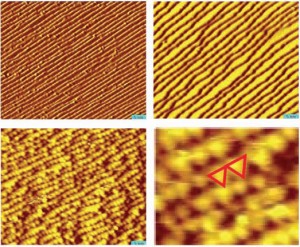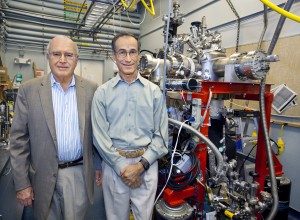When it comes to metal catalysts, the platinum standard is, well, platinum! However, at about $2,000 an ounce, platinum is more expensive than gold. The high cost of the raw material presents major challenges for the future wide scale use of platinum in fuel cells. Research at the U.S. Department of Energy (DOE)’s Lawrence Berkeley National Laboratory (Berkeley Lab) suggests that one possible way to meet these challenges is to think small – really small.

In these STM images of a platinum catalyst, (A) shows the terraced the surface under ultrahigh vacuum, (B) as the surface is covered with carbon monoxide and pressure increases, the terraces widen (C) when coverage is complete and press reaches one torr, the terraces fracture into nanoclusters (D) enlarged view shows triangular shape of the nanoclusters, two of which are marked by red lines.
A study led by Gabor Somorjai and Miquel Salmeron of Berkeley Lab’s Materials Sciences Division showed that under high pressure, comparable to the pressures at which many industrial technologies operate, nanoparticle clusters of platinum potentially can out-perform the single crystals of platinum now used in fuel cells and catalytic converters.
“We’ve discovered that the presence of carbon monoxide molecules can reversibly alter the catalytic surfaces of platinum single crystals, supposedly the most thermodynamically stable configuration for a platinum catalyst,” said Somorjai, one of the world’s foremost experts on surface chemistry and catalysis. “This indicates that under high-pressure conditions, single crystals of platinum are not as stable as nanoclusters, which actually become more stabilized as carbon monoxide molecules are co-adsorbed together with platinum atoms.”
“Our results also demonstrate that the limitations of traditional surface science techniques can be overcome with the use of techniques that operate under realistic conditions, says Salmeron, a leading authority on surface imaging and developer of the in situ imaging and spectroscopic techniques used in this study. He is also the director of Berkeley Lab’s Materials Sciences Division.
In this study, single crystal platinum surfaces were examined under high-pressure. The surfaces were structured as a series of flat terraces about six atoms wide separated by atomic steps. Such structural feature are common in metal catalysts and are considered to be the active sites where catalytic reactions occur. Single crystals are used as models for these features.
Somorjai and Salmeron coated the platinum surfaces in this study with carbon monoxide gas, a reactant involved in many important industrial catalytic processes, including the Fischer-Tropsch process for making liquid hydrocarbons, the oxidation process in automobile catalytic converters, and the degradation of platinum electrodes in hydrogen fuel cells. As carbon monoxide coverage of the platinum crystal surfaces approached 100-percent, the terraces began to widen – the result of increasing lateral repulsion between the molecules. When the surface pressure reached one torr, the terraces fractured into nanometer-sized clusters. The terraces were re-formed upon removal of the carbon monoxide gas.

Gabor Somorjai (left), an authority on catalysis, and Miquel Salmeron, an authority on surface imaging, used a high-pressure Scanning Tunneling Microscope to observe the surface of a platinum catalyst under actual industrial reaction conditions. (Image by Roy Kaltschmidt, Berkeley Lab Public Affairs)
“Our observations of the large-scale surface restructuring of stepped platinum highlights the strong connection between coverage of reactant molecules and the atomic structure of the catalyst surface,” says Somorjai. “The ability to observe catalytic surfaces at the atomic and molecular levels under actual reaction conditions is the only way such a phenomenon could be detected.”
Catalysts – substances that speed up the rates of chemical reactions without themselves being chemically changed – are used to initiate virtually every industrial manufacturing process that involves chemistry. Metal catalysts are the workhorses with platinum being one of the best. Industrial catalysts typically operate under pressures ranging from millitorr to atmospheres, and at temperatures ranging from room to hundreds of degrees Celsius. However, surface science experiments have traditionally been performed under high vacuum conditions and low temperatures.
“Such conditions will likely inhibit any surface restructuring process that requires the overcoming of even moderate activation barriers,” Somorjai says.
Says Salmeron, “The unanswered question today is what are the geometry and location of the catalyst atoms when the surfaces are covered with dense layers of molecules, as occurs during a chemical reaction.”
Somorjai and Salmeron have for many years been collaborating on the development of instrumentation and techniques that enable them to do catalysis studies under realistic conditions. They now have at their disposal unique high-pressure scanning tunneling microscopes (STM) and an ambient pressure x-ray photoelectron spectroscopy (AP-XPS) beamline operating at the Berkeley Lab’s Advanced Light Source, a premier source of synchrotron radiation for scientific research.
“With these two resources, we can image the atomic structure and identify the chemical state of catalyst atoms and adsorbed reactant molecules under industrial-type pressures and temperatures,” Salmeron says.
STM images revealed the formation of nanoclusters on the platinum crystal surfaces, and the AP-XPS spectra revealed a change in carbon monoxide electron binding energies. A subsequent collaboration with Lin-Wang Wang, a theorist in Berkeley Lab’s Computational Sciences Division, explained the change in structure as the result of the relaxation of the strong repulsion between carbon monoxide molecules that arises from their very high density on the surface when in equilibrium with elevated pressures of the gas.
“In the future, the use of these stable platinum nanoclusters as fuel cell catalysts may help to boost performance and reduce costs,” Somorjai says.The next step for Somorjai and Salmeron and their research team will be to determine whether other adsorbed reactants, such as oxygen or hydrogen, also result in the creation of nanoclusters in platinum. They also want to know if nanoclusters can be induced in other metal catalysts as well, such as palladium, silver, copper, rhodium, iron and cobalt.
“If this nanoclustering is a general phenomenon, it will have major consequences for the type of structures that catalysts must have under high-pressure, high-temperature catalytic reaction conditions,” Somorjai says.
A paper on this research appears in the journal Science, titled “Break-Up of Stepped Platinum Catalyst Surfaces by High CO Coverage.” Co-authoring this paper with Somorjai and Salmeron were Feng Tao, Sefa Dag, Lin-Wang Wang, Zhi Liu, Derek Butcher and Hendrik Bluhm.
This research was supported by the Basic Energy Sciences programs of the DOE Office of Science.
Berkeley Lab is a U.S. Department of Energy national laboratory located in Berkeley, California. It conducts unclassified scientific research for DOE’s Office of Science and is managed by the University of California. Visit our Website at www.lbl.gov/
Additional Information
For more information about the research of Gabor Somorjai, visit the Website at http://www.cchem.berkeley.edu/gasgrp/
For more information about the research of Miquel Salmeron visit the Website at http://stm.lbl.gov/Salmeron_group/home.html